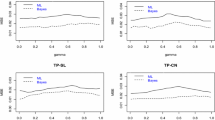Abstract
Models and parameters of finite mixtures of multivariate normal densities conditional on regressor variables are specified and estimated. We consider mixtures of multivariate normals where the expected value for each component depends on possibly nonnormal regressor variables. The expected values and covariance matrices of the mixture components are parameterized using conditional mean- and covariance-structures. We discuss the construction of the likelihood function, estimation of the mixture model with regressors using three different EM algorithms, estimation of the asymptotic covariance matrix of parameters and testing for the number of mixture components. In addition to simulation studies, data on food preferences are analyzed.
Similar content being viewed by others
References
Aitkin, M., Anderson, D., & Hinde, J. (1981). Statistical modelling of data on teaching styles.Journal of the Royal Statistical Society, Series A, 144, 419–461.
Aitkin, M. & Rubin, D.B. (1985). Estimation and hypothesis testing in finite mixture models.Journal of the Royal Statistical Society, Series B, 47, 67–75.
Arminger, G. (1995). Specification and estimation of mean structures: Regression models. In G. Arminger, C.C. Clogg, & M.E. Sobel (Eds.),Handbook of statistical modeling for the social and behavioral sciences (pp. 77–183). New York: Plenum.
Arminger, G., Wittenberg, J., & Schepers, A. (1996).MECOSA 3 User Guide. Friedrichsdorf/Ts., Germany: ADDITIVE GmbH.
Becker, M.P., Yang, I., & Lange, K. (1997). EM Algorithms without Missing Data.Statistical Methods in Medical Research, 6, 37–53.
Böhning, D., Dietz, E., Schaub, R., Schlattmann, P., & Lindsay, B.G. (1994). The distribution of the likelihood ratio for mixtures of densities from the one-parameter exponential family.Annals of the Institute of Statistical Mathematics, 46(2), 373–388.
Browne, M.W. (1974). Generalized least-squares estimators in the analysis of covariance structures.South African Statistical Journal, 8, 1–24.
Browne, M.W. (1977). Generalized least-squares estimators in the analysis of covariance structures. In D.J. Aigner, & A.S. Goldberger (Eds.),Latent variables in socio-economic models (pp. 205–226). Amsterdam: North-Holland.
Browne, M.W. & Arminger, G. (1995). Specification and estimation of mean- and covariance-structure models. In G. Arminger, C.C. Clogg, & M.E. Sobel (Eds.),Handbook of statistical modeling for the social and behavioral sciences (pp. 185–249). New York: Plenum.
Brunsø, K., & Grunert, K.G. (1993).Identifying food-related life style segments by a cross-culturally valid scaling device. MAPP Conference Paper, The Aarhus School of Business, Department of Marketing, Haslegaardsvej 10, DK-8210 Aarhus 5, Denmark.
Dempster, A.P., Laird, N.M., & Rubin, D.B. (1977). Maximum likelihood from incomplete data via the EM algorithm (with Discussion).Journal of the Royal Statistical Society, Series B, 39, 1–38.
DeSarbo, W.S., & Cron, W.L. (1988). A maximum likelihood methodology for clusterwise linear regression.Journal of Classification, 5, 249–282.
Jedidi, K., Jagpal, H.S., & DeSarbo, W.S. (1997). Finite-mixture structural equation models for response-based segmentation and unobserverd heterogeneity.Marketing Science, 16(1), 39–59.
Jedidi, K., Ramaswamy, V., DeSarbo, W.S., & Wedel, M. (1996). On estimating finite mixtures of multivariate regression and simultaneous equation models.Structural Equation Modelling, 3, 266–289.
Jones, P.N., & McLachlan, G.J. (1992). Fitting finite mixture models in a regression context.Australian Journal of Statistics, 32(2), 233–240.
Jöreskog, K.G., & Sörbom, D. (1988).LISREL 7-A Guide to the Program and Applications. Chicago, IL: SPSS Publications.
Kiefer, N.M. (1978). Discrete parameter variation: Efficient estimation of a switching regression model.Econometrica, 46, 427–434.
Louis, T.A. (1982). Finding the observed information matrix when using the EM algorithm.Journal of the Royal Statistical Society, Series B, 44, 226–233.
McLachlan, G.J. (1987). On bootstrapping the likelihood ratio test statistic for the number of components in a normal mixture.Applied Statistics, 36(3), 318–324.
McLachlan, G.J., & Basford, K.E. (1988).Mixture models. New York: Marcel Dekker.
Titterington, D.M., Smith, A.F.M., & Makov, U.E. (1985).Statistical analysis of finite mixture distributions. Chiester: Wiley.
Wolfe, J.H. (1971). A Monte Carlo study of the sampling distribution of the likelihood ratio for mixtures of multinormal distributions (Technical Bulletin STB 72-2). San Diego: U.S. Naval Personnel and Training Research Laboratory.
Yung, Y.F. (1994).Finite mixtures in confirmatory factor-analytic models. Unpublished doctoral dissertation, University of California, Los Angeles, Department of Psychology.
Yung, Y.F. (1997). Finite mixtures in confirmatory factor-analysis models.Psychometrika, 62, 297–330.
Author information
Authors and Affiliations
Additional information
The authors are grateful to Donald B. Rubin and Michael E. Sobel for critical reading of a first draft of this paper and to three anonymous reviewers ofPsychometrika for their helpful comments and suggestions. The research of the first and the third author was supported by a grant from the Deutsche Forschungsgemeinschaft.
Rights and permissions
About this article
Cite this article
Arminger, G., Stein, P. & Wittenberg, J. Mixtures of conditional mean- and covariance-structure models. Psychometrika 64, 475–494 (1999). https://doi.org/10.1007/BF02294568
Received:
Revised:
Issue Date:
DOI: https://doi.org/10.1007/BF02294568




